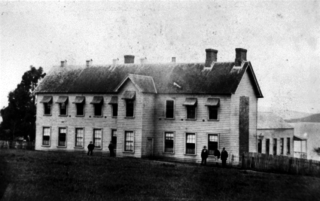Related Research Articles

The 1st New Zealand Parliament was a term of the Parliament of New Zealand. It opened on 24 May 1854, following New Zealand's first general election. It was dissolved on 15 September 1855 in preparation for that year's election. 37 Members of the House of Representatives (MHRs) represented 24 electorates.

William Thomas Locke Travers was a New Zealand lawyer, politician, explorer, and naturalist.
William Oldfield Cautley was a New Zealand settler and politician.

Nelson is a New Zealand parliamentary electorate, returning one Member of Parliament to the House of Representatives of New Zealand. From 1853 to 1860, the electorate was called Town of Nelson. From 1860 to 1881, it was City of Nelson. The electorate is the only one that has continuously existed since the 1st Parliament in 1853.

Francis Jollie was a politician in New Zealand.
Wairau was a parliamentary electorate in the Marlborough Region of New Zealand. It was one of the initial 24 New Zealand electorates and existed from 1853 until its abolition in 1938, when it was succeeded by the Marlborough electorate. The electorate had 13 representatives during its existence. The 1861 election in the Wairau electorate was notable in that a later Premier, Frederick Weld, was unexpectedly and narrowly defeated by William Henry Eyes.
Waimea was a parliamentary electorate in the Nelson Province of New Zealand, from 1853 to 1887. Initially represented by two members, it was a single-member electorate from 1861.
Collingwood was a parliamentary electorate in what is now the Tasman region of the South Island of New Zealand from 1861 to 1881.
The Suburbs of Nelson is a former parliamentary electorate around the city of Nelson, New Zealand from 1861 to 1881.
The 4th New Zealand Parliament was a term of the Parliament of New Zealand.

John Fedor Augustus Kelling, JP, known as Fedor Kelling, was a 19th-century Member of the New Zealand Parliament, representing Nelson. A leader of a group of immigrants from Germany, he also served as the German consul.

Edward Baigent was a 19th-century Member of Parliament from Nelson, New Zealand. He was one of the most successful saw-millers of the region, and his company existed for well over 100 years.
The New Zealand Constitution Act 1852 authorised the General Assembly to establish new electoral districts and to alter the boundaries of, or abolish, existing districts whenever this was deemed necessary. The rapid growth of New Zealand's European population in the early years of representative government meant changes to electoral districts were implemented frequently, both at general elections, and on four occasions as supplementary elections within the lifetime of a parliament.
The 1854 City of Auckland by-election was a by-election held in the multi-member City of Auckland electorate on 4 August 1854 during the 1st New Zealand Parliament. It was one of the earliest by-elections in New Zealand political history and was triggered by the resignation of Thomas Bartley. Bartley resigned on 11 July 1854 to take up a place in the Legislative Council.
The 1854 Town of Nelson by-election was a by-election held in the multi-member electorate of Town of Nelson during the 1st New Zealand Parliament, on 17 June 1854, and was the first by-election in New Zealand political history.
The Grey and Bell by-election 1858 was a by-election held in the Grey and Bell electorate during the 2nd New Zealand Parliament, on 17 May 1858, and was, the second by-election in the electorate.

The Dunedin Country by-election 1858 was a by-election held in the multi-member Dunedin Country electorate during the 2nd New Zealand Parliament, on 16 June 1858. The by-election was caused by the resignation of incumbent MP John Cargill and was won by John Taylor.
The Oamaru by-election 1885 was a by-election held in the Oamaru electorate during the 9th New Zealand Parliament, on 20 May 1885. The by-election was caused by the resignation of the incumbent, Samuel Shrimski, who was appointed to the Legislative Council, and was won by Thomas William Hislop.
The 1859 Town of Dunedin by-election was a New Zealand by-election held in the single-member electorate of Town of Dunedin during the 2nd New Zealand Parliament on 14 January 1859, after the resignation of James Macandrew. The election was won by Macandrew, who had resigned from his seat on 2 November 1858 as a result of not attending a parliamentary session earlier in his term.
The April 1865 Bruce by-election was a New Zealand by-election held in the multi-member electorate of Bruce during the 3rd New Zealand Parliament on 8 April 1865. It was triggered on 9 January that year by the resignation of separationist Thomas Gillies and won by prominent settler Arthur John Burns. The more liberal businessman William John Dyer was the sole other contester of the by-election, finishing with 43.33% of the vote.